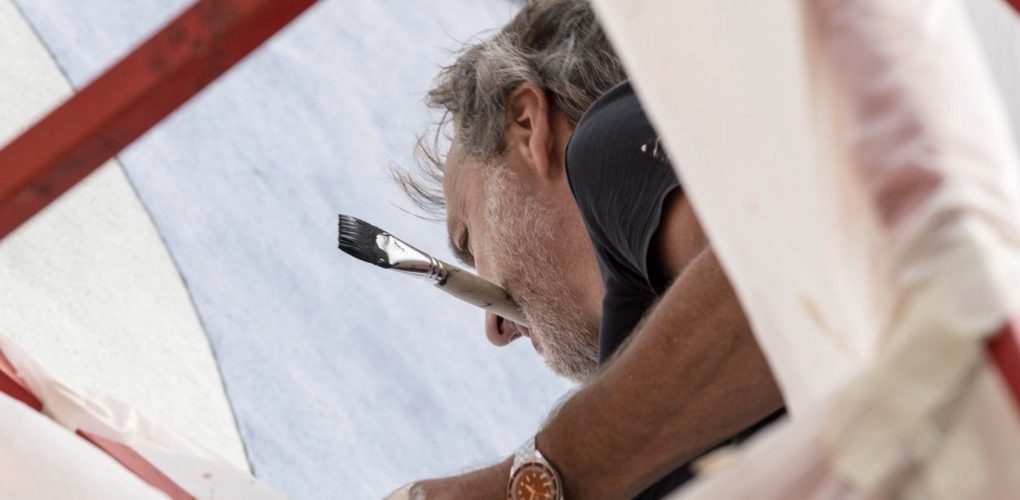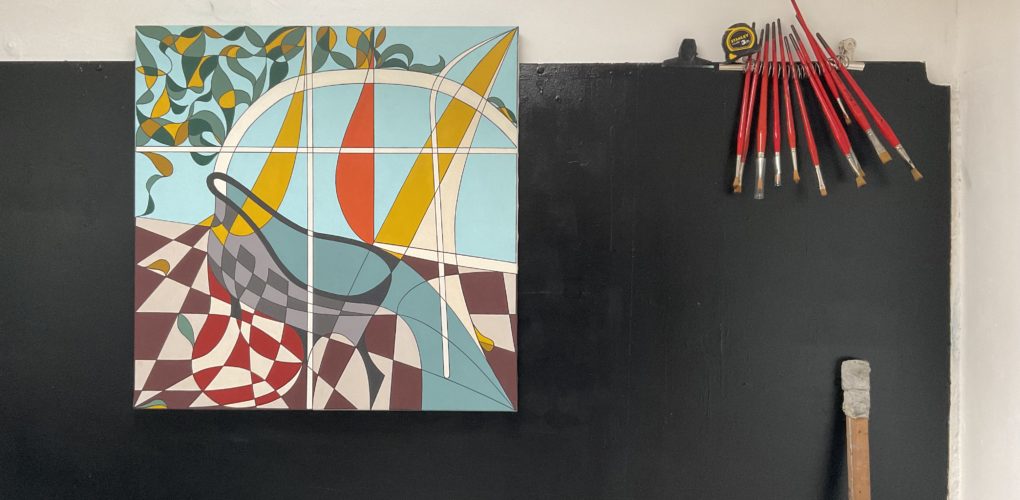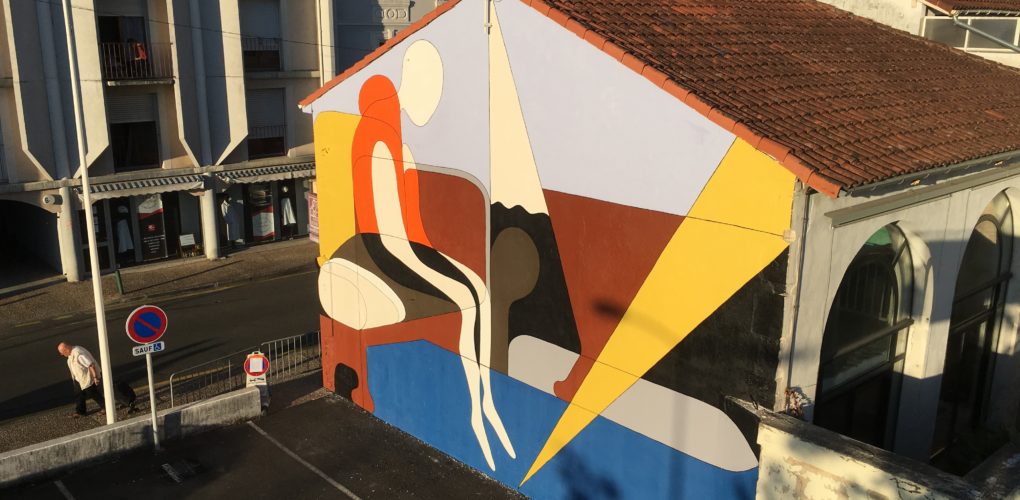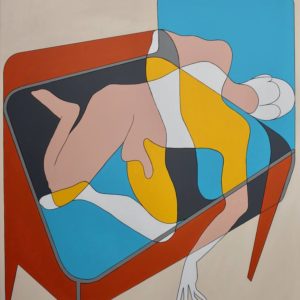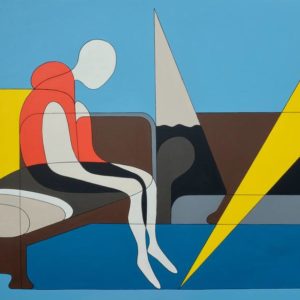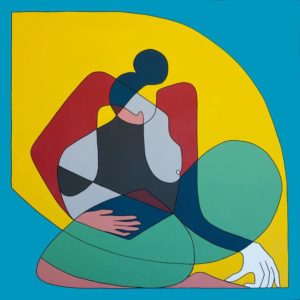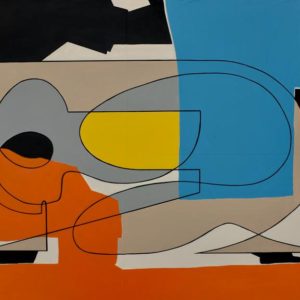One to Watch
 Where Intuition and Mathematics Meet with Jean-Luc Feugeas
Where Intuition and Mathematics Meet with Jean-Luc Feugeas
As the saying goes, you have to learn the rules in order to break them. For Jean-Luc Feugeas, a French painter with a PhD in mathematics who now works as a university researcher in theoretical physics, the rules of perspective and the principles of geometry ebb and flow on the canvas, bending to the artist’s intuition. The results are fragmentary, colorful compositions wherein figures coalesce with their surroundings. Slouching and sprawled across furniture, or pensively caving inward onto themselves, the figures in Jean-Luc’s works come alive in their movements, seemingly conscious of the illogical spaces that contain them. Addressing themes such as relationships, longing, and migration, these formally fragmented spaces become metaphors for the social and political spaces that we, the viewers, navigate everyday.
Jean-Luc’s work has been collected internationally, with works held in private collections throughout North America, Europe, and East Asia. He has exhibited around the world, with his most recent exhibition at Frogman Gallery in Beijing. He has also been commissioned for numerous public mural projects, including the 2019 mural Un Sauvage on the occasion of Muralis, the Festival of Urban Art in Dax, France.
Tell us about who you are and what you do. What’s your background?
As far back as I can remember, I have always divided my time between drawing and music. Mathematics imposed itself. Painting came to me later. Music never left me. Over time I figured out my approach is one of a researcher, both as a scientist and as an artist.
What does your work aim to say? What are the major themes you pursue in your work?
The themes I deal with are perfectly ordinary: I speak about people, family, love, absence, society, life—its torments and its appeasements… Meetings mainly feed my painting.
Can you walk us through your process for creating a work from beginning to end?
The initial intention feeds my first pencil lines on paper. The lines then follow one another. I choose to privilege my intuition of reality to the elementary rules of a realistic representation: a character can be confused with a table or a chair; a swimming pool can appear in a room. I free myself from the rules of perspective and proportion. The gestures follow one another and circulate. Accidents follow one another, sometimes with happiness. They guide me if I know how to decipher them. This succession of balances and imbalances, tensions and resolutions, instills a breath, assisted at first and more durably afterwards.
And then, a detail appears. It justifies everything and the breath settles. The trajectories then follow one another, meet, fade, correct, and complete each other. The initial intention resurfaces. I obey. I want only one line. Then, I put the colors, I oppose them and associate them. I resolve a multitude of minute imbalances until the emergence of a global balance, which, when reached, marks the end of this divergent phase. The line then closes. The canvas is finished.
Who are your biggest influences and why?
I singularly lack in originality because my influences mainly come from the very famous figures of art. If I were to choose, here are the main ones: Le Corbusier because he is an explorer and a precursor; Wassily Kandinsky because he is both a theoretician and a practitioner in art; Robert Rauschenberg because he knew that disorder is equilibrium; Pablo Picasso because he never stopped inventing.
In addition, I keep very preciously advice from my two mentors: my piano and harmony professor taught me to listen; and my scientific mentor, a Russian professor of physics, taught me the importance of integrity.
How does your work comment on current social and political issues?
To answer this question, I choose the example of the piece Un Sauvage. This has been created [as a mural] for the French Urban Art Festival; it is also one of my paintings. Un Sauvage is about those who leave for a simple journey or for a better life. Those who have decided to draw their borders and territories. Those who follow their own line and who dream of freedom. Un Sauvage is the day after the big day, the day of the longed-for departure. It is also the day of an inexorable shipwreck. Un Sauvage is the story of those who, captive of a makeshift boat, are abandoned at sea under an overwhelming sun, with others. Many others. Like them. Migrants, who dreamed of this “better world” that now considers them unworthy. Which treats them like savages. This is the story of a rescue that will never come.
It is a line of horizon or arrival, a line of flight or political, a line of life, of floating and finally a line of sight… Un Sauvage is the story of a shipwreck. Ours, no doubt. The shipwreck, a model of democracy. Of an ideal. It is the observation of a consented brutality, of our egoism, of our individual and collective cowardice which is transformed into a human catastrophe which ends up blowing up in our faces. Un Sauvage is a feeling of helplessness.
What memorable responses have you had to your work?
My work has been called “post-neo-modern” by a curator. I found it great fun and, in fact, I sure like it. More seriously, sometimes, people who own my paintings contact me. It is very disturbing, because by listening to them speaking about my work, I understand that the process that I have initiated is continuing on without me. The observer makes the work. It is the quantum dimension of art!
Love reading about all things art? You can have articles from Canvas, curated collections, and stories about emerging artists delivered straight to your inbox. Sign up for the Saatchi Art Newsletter.

